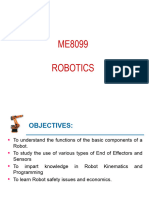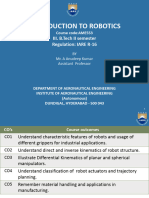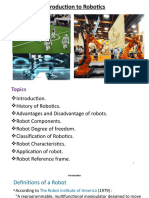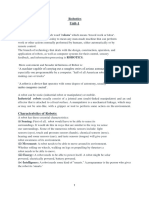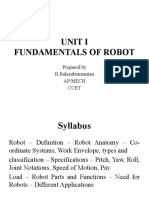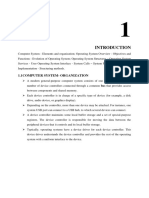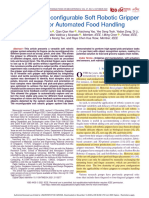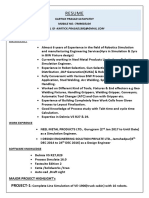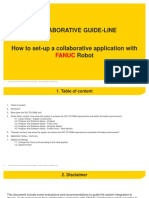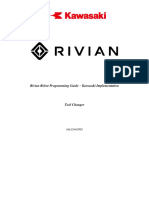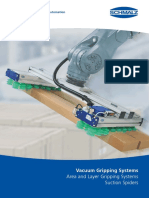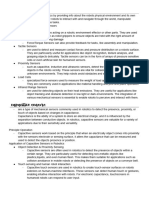2 Marks Foundation of robotics
Uploaded by
Akshana Arash2 Marks Foundation of robotics
Uploaded by
Akshana ArashRobo�cs 2 Marks
Unit 1
1. Asimov’s laws of Robo�cs:
Isaac Moscos Three Law of Robo�cs are a set of ethical guidelines
for robots that are o�en considered the founda�on for developing
autonomous systems.
1st law: a robot must not harm a human or a hello a human to be
home by in ac�on
2nd law: a robot must follow orders from human unless those orders
conflict with the first law
3rd law: a robot must protect itself as long as that protec�on does
not conflict with the other two laws.
2. Work envelop:
• Work and area which robot can reach.
• The space in which the end pointer of the robot arm is capable for
opera�ng is called what space are work envelope
• Work envelope if the shape created when manipulated or rich
forward backward up and down.
• The distance or determined by the length of robot arm and design
of each axis. Each access contributes its all range of monitors.
• A robot can perform within the work envelope.
3. Robot Anatomy:
• Robot anatomy is defined as the study of structure of robots
• It deals with their physical construc�on of the arm and wrist of the
robot.
• A giant provides rela�ve mo�on between the input link and the
output link.
• It has three physical configura�on that is:
a. Body that atached to the base
b. Arm that atached to the body
c. Wrist that atached to the arm.
4. RGV ( Rail Guided Vehicle):
• A Rail Guided Vehicle (RGV) is an automated vehicle used in
industrial environments, par�cularly in manufacturing, logis�cs,
and warehousing.
• It moves along a fixed rail or track and is designed to transport
materials or components between predefined loca�ons.
• RGVs are o�en part of a larger automated material handling
system (AMHS).
5. Robot:
• A robot is a programmable machine which is capable of doing
complex task automa�cally with precision and efficiency.
• The robots can be guided by external or internal input to perform
any work.
• Robots are manufactured by American inventor by George Devol
in 1950 and used in 1954. He is called as father of Robots.
6. Applica�ons of Robots:
• Manufacturing
• Material handling
• Healthcare
• Food processing
• Entertainment
• Military
• Explora�on
• Hazardous environments
• Laboratory Specimens
7. Types of robots:
• Fixed Robots – A fixed robot is atached to a sta�onary pla�orm. It
remains in one place while doing the task assigned to it just like a
person who stands in one place while working.
• Mobile robots – A mobile robot moves from one place to another
by wheels or legs. These are usually prefer for rough surface and
legs for smooth surface.
8. Economic analysis of robots:
• Economic analysis means to help bring about a beter alloca�on of
resources that can lead to enhanced incomes for investment or
consump�on purposes.
• Economic analysis is a process whereby the strength and weakness
of an economy are analysed.
• Types of economic analysis are cost effec�veness, cost benefit
analysis, programming cost analysis and economic impact analysis.
9. Joint Nota�on:
• Joint nota�on in robo�cs refers to the representa�on of joints in a
robo�c system par�cularly in robo�c arms where different types
of joints allow specific type of Movement.
• This nota�on helps in understanding and classifying the mo�ons
capability of robo�c manipulator.
• The common type of joint nota�on also known as Denavit-
Hartenberg Nota�on are Linear joint (L), Revolving joint (V),
Twis�ng joint(T), Orthogonal joint (O) and Rota�onal joint (R).
10. AVG (Automated Guided Vehicle):
• An Automated Guided Vehicle (AGV) is a mobile robot used in
industrial and logis�cs se�ngs to transport materials without the
need for human interven�on.
• AGVs follow predefined paths, guided by markers, wires, lasers, or
cameras.
• These are commonly employed to enhance opera�onal efficiency,
reduce labor costs, and improve safety in workplaces.
11.Pitch:
• Pitch is the rota�on about the Y-axis (lateral axis). This movement
�lts the object or robo�c component up or down.
Posi�ve pitch: The front of the object moves up.
Nega�ve pitch: The front of the object moves down.
• Example in Robo�cs:
Adjus�ng the angle of a robo�c arm to pick an object at a
higher or lower eleva�on.
Til�ng a robo�c head to look up or down.
12. Yaw:
• Yeah the rota�on about the Z Axis. This movement rotates the
object le� or right in the horizontal plane.
Posi�ve yaw: The object rotates to the right.
Nega�ve yaw: The object rotates to the le�.
• Example in Robo�cs:
Rota�ng the base of a robo�c arm to change its direc�on of
reach.
Turning a mobile robot to navigate a path.
13.Roll:
• Roll is the rota�on about the X-axis (longitudinal axis). This
movement causes the object to �lt sideways, like a barrel roll.
Posi�ve roll: The right-side �lts downward.
Nega�ve roll: The le� side �lts downward.
• Example in Robo�cs:
Rota�ng a robo�c gripper to align it with an object.
Stabilizing an aerial drone when one side is �lted.
14. Zeroth Law of Robo�cs:
• The Zeroth Law of Robo�cs is an extension of Isaac Asimov's
famous Three Laws of Robo�cs.
• It states that ”A robot may not harm humanity, or, by inac�on,
allow humanity to come to harm.”
15.Classifica�on of robots:
• Based on applica�on
o Industrial robots
o Service robots
o Robots next slide explora�on robots
o Military robots
o Humanoid robots
• Based on geometry or structure
o Cartesian robots
o Cylindrical robots
o Polar robots
o Joint robots
o SCARA Robots (Selec�ve Compliance Assembly Robot Arm)
• Based on locomo�on
o Wheeled Robots
o Legged Robots
o Tracked Robots
o Aerial Robots
o Underwater Robots
• Based on Control Method
o Manual
o Autonomous
o Semi-Autonomous Robots
• Based on Level of Autonomy
o Fully Autonomous Robots
o Semi-Autonomous Robots
o Remotely Operated Robots
• Based on Power Source
o Electric Robots
o Hydraulic Robots
o Pneuma�c Robots
• Based on Interac�on with Environment
o Fixed Robots
o Mobile Robots
16.Robot Parts and Their Func�on
• Body/ Structure – Provides structural support and houses internal
components.
• Power/ Drive system - Provides energy for the robot's opera�on.
• Controller - Acts as the brain of the robot, processing inputs from
sensors and sending commands to actuators.
• Manipulator/ Arm - Moves and posi�ons the end effector.
• End Effector - Performs tasks such as gripping, welding, cu�ng, or
pain�ng.
• Processor/CPU - Processes data and executes algorithms for
decision-making, control, and AI tasks.
17.SCARA Robots :
• Kara is similar to join arm except the shoulder and elbow rota�on
axis
• It has three axes (XYZ) axis where X and Y are not linear and Z is
linear
• All the motor are in the baseline
• Advantages
o High speed capabili�es
o Good to work top to botom
o It is faster and cleaner
• Disadvantages
o Complex arm Structure
o Difficult for offline Programs
18.Pay Load
• Payload tracking maintain alignment between appalled and target
while both payload and the target may be moving.
• The ability to achieve payload tracking while moving is important
for mobile robots as it can enable a variety of tasks including
Teleporta�on, wireless communica�on, mobile survey etc..
Unit 2
1. Homogeneous Transforma�on matrix
2. Manipulator dynamics
• Refers to the study of forces and torques in robo�c manipulators
considering mo�on and external loads.
• Includes:
o Kine�cs: Relates forces/torques to mo�on.
o Kinema�cs: Studies mo�on without considering forces.
• Applica�ons:
o Designing controllers for precise mo�on.
o Simula�ng manipulator behavior under varying loads.
3. Degeneracy:
• A condi�on where a robo�c manipulator loses one or more degrees
of freedom, leading to limited movement or control.
• Typically occurs when the Jacobian matrix becomes singular (non-
inver�ble).
• Results in:
o Inability to move in certain direc�ons.
o Reduced control over the end-effector's posi�on or
orienta�on.
4. Dexterity
• Describes the ability of a robo�c manipulator to achieve precise and
complex movements.
• Dependent on:
o The configura�on of joints.
o The manipulator's workspace geometry.
• A robot with high dexterity can posi�on and orient its end-effector
accurately in various direc�ons.
5. Degree of Freedom (DOF)
• Refers to the number of independent movements or parameters
required to define the robot's posi�on and orienta�on.
• Each joint provides one degree of freedom:
o Rota�onal joints: Allow angular movement.
o Prisma�c joints: Allow linear movement.
• Determines the robot's versa�lity and complexity.
6. Difference between forward and Inverse Kinema�cs
7. Forward Kinema�cs:
• FK is the process of calcula�ng the posi�on and orienta�on of the end
points of chain of joints based on the angles and joint posi�on.
• Transforming from joint space to world space is called FK
8. Reverse Kinema�cs
• Invest kinema�cs is the opposite of forward kinema�cs
• It is the process of calcula�ng the angles and length of each joint
based on the desired posi�on and orienta�on of the endpoint of a
chain of joints.
Unit 3
1. Mechanical grippers and its types
• Mechanical grippers are the most common type of end effectors
used in robo�c systems.
• They u�lize mechanical fingers or jaws to grasp, hold, and
manipulate objects.
• The design and mechanism of mechanical grippers can vary widely,
depending on the applica�on requirements.
• Types:
o Two-Finger Grippers - Simple and widely used, suitable for
cylindrical or rectangular objects.
o Three-Finger Grippers - Offers beter stability for round
objects.
o Mul�-Finger Gripper - Designed for complex shapes or delicate
objects.
o Adap�ve Grippers - Can adjust their shape to conform to the
object being grasped
2. Grippers and Their Use
• Grippers in robo�cs are devices used to grasp, manipulate, and
release objects.
• They are essen�al components of robo�c systems, par�cularly in
automa�on and manufacturing, as they enable robots to interact with
objects in their environment
• Uses:
o Assembly opera�ons in manufacturing.
o Pick-and-place applica�ons in logis�cs.
o Handling delicate items like glass or electronics.
o Suppor�ng automa�on in welding, pain�ng, and inspec�on
tasks.
3. End Effector:
• End effector is a device that is atached to the wrist of robot arm so as
to enable the robot to perform a specific task.
• It is some �me referred as the hand of the robot.
• End effectors must be custom engineered for the par�cular task which
is to be performed.
• End effectors used to grab and hold objects.
• The objects are generally work parts that are to be moved by robot.
• The two major categories of end effectors are:
i. Grippers
ii. Tools Grippers
4. Pneuma�c Grippers:
• A pneuma�c gripper is a pick-and-place device that uses compressed
air to operate gripper jaws, also called fingers.
• These fingers, similar to human fingers, help in grasping, holding and
releasing the work pieces. Commonly, they have 2 fingers (parallel or
angular) or 3 fingers with a single or double ac�ng cylinder for control.
• They are mostly used in automated manufacturing processes to grip a
work piece.
5. Hydraulic Grippers:
• Hydraulic grippers are heavy-duty li�ing devices that can apply the
force required to handle heavy components.
• They use pressurised fluids to move a piston.
• When the piston moves, it transfers the force to the gripper jaws,
opening and closing them
• They employ hydraulic fluid to precisely operate their jaws, par�cularly
excelling in tasks that entail handling sizable and weighty objects
demanding substan�al gripping force.
6. AC vs DC Servo Motor
7. Differen�ate Pneuma�c and Hydraulic Drives
8. Differen�ate Internal and External Grippers
9. Proper�es and Limita�ons of Stepper Motors
• Proper�es:
o Precise posi�on control.
o Open-loop opera�on.
o High torque at low speeds.
• Limita�ons:
o Limited speed and efficiency.
o Prone to resonance issues.
10.Types of Stepper motor:
11. Applica�ons of Drives
• Pneuma�c Drive Systems
o Manufacturing
o Automa�on
o Packaging Industry
o Transporta�on
o Healthcare
• Hydraulic Drive Systems
o Heavy Machinery
o Automo�ve
o Industrial Presses
o Marine Applica�ons
o Aerospace
• Mechanical Drive Systems
o Automo�ve
o Tex�le Industry
o Construc�on Equipment
o Agriculture
o Energy Sector
• Electric Drive Systems
o Industrial Automa�on
o Transporta�on
o Home Appliances
o Renewable Energy
o Healthcare
12.Electrical Motor:
• Electrical drives play a vital role in robo�cs, providing precise control
over the mo�on and opera�on of robo�c systems.
• These drives convert electrical energy into mechanical mo�on and are
integral to achieving the desired performance and func�onality of
robots.
• Applica�ons:
o Precision control in CNC machines.
o Energy-efficient systems in HVAC.
o Automo�ve systems like power steering.
Unit 4
1. TOUCH SENSOR
• A touch sensor is a type of equipment that captures and records
physical touch (or) embrace on a device and object.
• It enables a device (or) object to detect touch, typically by a human
user (or) operator.
• A touch sensor may also be called a touch detector. Touch sensor,
which sense the presence (or) absence of the objects by having
physical contact between the objects.
2. Tac�le Sensor
• Tac�le sensor is device that indicates the contact between
themselves and some other solid objects.
• Tac�le sensor is a par�cular form of pressure sensor and used on the
finger�ps of robots to determine contact of hand with object.
• They are used for touch display screens where a physical contact has
to be sensed.
3. Iden�fica�on:
• The process of recognizing, dis�nguishing, or categorizing objects,
paterns, or signals based on specific features or atributes.
• Key Aspects
o Object Iden�fica�on
o Patern Recogni�on
o Biometric Iden�fica�on
o Robo�c Systems
o Industrial Applica�ons
4. Sniff Sensor
• Defini�on: A sensor used to detect gases or chemical substances in
the environment, o�en mimicking the sense of smell.
• Working Principle: Usually involves detec�ng specific molecules in
the air using chemical sensors or gas sensors.
• Applica�ons:
o in Air quality monitoring in environmental systems.
o Leak detec�on industrial plants.
o Detec�ng toxic gases in confined spaces for safety.
5. Triangula�on
• Defini�on: A technique used for determining the loca�on of an object by
measuring angles from two fixed points.
• Working Principle: The distance and posi�on of an object are
determined using the geometry of triangles formed by the object and
the two measurement points.
• Applica�ons:
o 3D scanning and modeling.
o Robo�cs for precise naviga�on and posi�oning.
o LIDAR (Light Detec�on and Ranging) systems for mapping and
surveying.
6. Feature Extrac�on
• Defini�on: The process of transforming raw data into a set of features
that can be used for further analysis, recogni�on, or processing.
• Methods:
o Edge detec�on in images.
o Fourier or wavelet transforms for signal processing.
o Principal component analysis (PCA) for dimensionality reduc�on.
• Applica�ons:
o Image recogni�on in machine vision.
o Speech recogni�on systems.
o Data mining in AI models.
7. Linear Variable Differen�al Transformer (LVDT)
• Defini�on: A sensor that measures linear displacement or posi�on by
detec�ng changes in inductance.
• Components: Consists of a primary coil and two secondary coils, with a
movable ferromagne�c core.
• Applica�ons:
o Precision measurement of linear mo�on in machinery.
o Posi�on sensing in industrial automa�on.
o Spacecra� for measuring structural deflec�ons.
8. Differen�ate Between Sensors and Actuators
9. Differen�ate Between Sensors and Transducers
10. Data Reduc�on
• Defini�on: The process of reducing the volume of data by removing
redundant informa�on while preserving essen�al details.
• Techniques:
o Compression algorithms (e.g., Huffman coding).
o Sampling and filtering of data.
o Principal Component Analysis (PCA) for dimensionality reduc�on.
• Applica�ons:
o Image compression in digital media.
o Signal processing in communica�on systems.
o Reducing processing load in large datasets.
11.Smoothing in Vision Systems
• Defini�on: The process of reducing noise in visual data to improve image
quality and feature extrac�on.
• Methods:
1. Gaussian smoothing for noise reduc�on.
2. Median filtering to remove outliers.
3. Moving average for temporal smoothing in video processing.
• Applica�ons:
1. Object detec�on and recogni�on in computer vision.
2. Medical imaging for clearer scans.
3. Real-�me video processing for robo�cs.
12.Thresholding
• Defini�on: A technique used in image processing to convert grayscale
images into binary images by applying a threshold value.
• Types:
1. Global thresholding (same threshold for the en�re image).
2. Adap�ve thresholding (different thresholds for regions).
• Applica�ons:
1. Edge detec�on in computer vision.
2. Object segmenta�on in automated inspec�on.
3. Fingerprint recogni�on systems.
13.Camera
• Defini�on: A device used to capture visual data, typically in the form of
s�ll images or video.
• Types:
1. CCD (Charge-Coupled Device) cameras.
2. CMOS (Complementary Metal-Oxide-Semiconductor) cameras.
• Applica�ons:
1. Surveillance and security.
2. Machine vision in robo�cs.
3. Medical imaging (e.g., endoscopy).
14.Sensing
• Defini�on: The process of detec�ng and responding to external s�muli,
such as temperature, light, or pressure.
• Types:
1. Physical sensing (e.g., temperature, humidity).
2. Chemical sensing (e.g., gas detec�on).
• Applica�ons:
1. Environmental monitoring systems.
2. Wearable devices for health tracking.
3. Autonomous vehicles for obstacle detec�on.
15.Digi�zing Image Data
• Defini�on: The process of conver�ng analog image data into digital form
using sensors like cameras or scanners.
• Methods:
1. Sampling: Capturing discrete values at fixed intervals.
2. Quan�za�on: Assigning discrete values to each sampled point.
• Applica�ons:
1. Digital photography.
2. Medical imaging (e.g., MRI, CT scans).
3. Computer vision and robo�cs.
16.Compliance Mechanism
• Defini�on: A system designed to adapt to external forces or
deforma�ons, ensuring safe interac�on with the environment.
• Types:
1. Passive compliance (e.g., springs, dampers).
2. Ac�ve compliance (e.g., sensors and motors controlling
movement).
• Applica�ons:
1. Collabora�ve robots (cobots) working with humans.
2. Grippers handling delicate or irregularly shaped objects.
3. Medical devices such as prosthe�cs or rehabilita�on robots.
17.Image Storage
• Defini�on: The process of saving image data in digital form, typically in
file formats like JPEG, PNG, or TIFF.
• Methods:
1. Compression to reduce file size.
2. Cloud storage for accessibility.
• Applica�ons:
1. Archiving digital photos and videos.
2. Storing images in databases for retrieval and analysis.
3. Backup systems for security and surveillance footage.
18.Differen�ate Between Ac�ve and Passive Compliance
19.Ligh�ng Techniques
• Defini�on: Methods used to illuminate a scene or object for visual
inspec�on or imaging.
• Types:
1. Front ligh�ng: Illumina�ng from the front of the object.
2. Backligh�ng: Illumina�ng from behind the object for silhouete
effects.
3. Diffused ligh�ng: So�, uniform ligh�ng to reduce shadows.
• Applica�ons:
1. Machine vision for quality control.
2. Photography for object visibility.
3. Document scanning.
20.Signal Conversion
• Defini�on: The process of conver�ng a signal from one form to another,
o�en from analog to digital or vice versa.
• Types:
1. Analog-to-digital conversion (ADC).
2. Digital-to-analog conversion (DAC).
• Applica�ons:
1. Audio and video signal processing.
2. Sensor data processing in robo�cs.
3. Communica�on systems.
21.Object Recogni�on
• Defini�on: The process of iden�fying and classifying objects in an image
or video stream.
• Methods:
1. Feature-based recogni�on (e.g., SIFT, SURF).
2. Deep learning-based recogni�on using CNNs (Convolu�onal
Neural Networks).
• Applica�ons:
1. Autonomous vehicles for object detec�on.
2. Robo�cs for pick-and-place opera�ons.
3. Security systems for threat detec�on.
22.Frame Grabber
• Defini�on: A device or card that captures image or video frames from a
camera or video source and transfers them to a computer.
• Types:
1. PCI-based frame grabbers.
2. USB or FireWire-based frame grabbers.
• Applica�ons:
1. Image processing in industrial automa�on.
2. Video capture for surveillance systems.
3. Real-�me video analysis in medical imaging.
23.Force Sensor
• Defini�on: A sensor used to measure force or pressure applied to an
object or surface.
• Types:
1. Strain gauges.
2. Piezoelectric sensors.
3. Capaci�ve sensors.
• Applica�ons:
1. Robo�c arms for grip force control.
2. Touch-sensi�ve applica�ons.
3. Structural health monitoring in civil engineering.
24.Proximity Sensor
• Defini�on: A sensor that detects the presence or absence of an object
within a specified range without physical contact.
• Types:
1. Induc�ve proximity sensors (detect metal objects).
2. Capaci�ve proximity sensors (detect non-metal objects).
3. Ultrasonic proximity sensors (measure distance based on sound
waves).
• Applica�ons:
1. Industrial automa�on for object detec�on.
2. Robo�cs for obstacle avoidance.
3. Consumer electronics like smartphones for touch detec�on.
Unit 5
1. Robot Programming Languages
• Defini�on: A set of programming languages specifically designed to
instruct robots and automate tasks in manufacturing or service
environments.
• Types of Programming Languages:
1. Text-based:
LISP, C, C++: General-purpose languages adapted for
robo�cs.
Python: Popular for machine learning and scrip�ng robo�c
func�ons.
ROS (Robot Opera�ng System): A framework that uses
Python and C++ for robot control and simula�on.
2. Graphical Languages:
VPL (Visual Programming Languages): Graphical interfaces
for programming robots (e.g., Scratch, Blockly).
RobotStudio, RoboBuilder: Specialized visual programming
tools for industrial robots.
• Applica�ons:
1. Robo�cs educa�on and research.
2. Industrial automa�on in factories.
3. Control of autonomous systems like drones or robo�c arms.
2. Trajectory Planning
• Defini�on: The process of determining a path or trajectory for a robot to
follow, considering its dynamics, kinema�cs, and constraints.
• Methods:
1. Point-to-Point Planning: The robot moves from one point to
another without intermediate steps.
2. Con�nuous Path Planning: A smooth, con�nuous trajectory is
created for tasks such as drawing or welding.
3. Op�mal Trajectory Planning: Minimizes energy or �me while
mee�ng the robot’s speed and accelera�on limits.
• Applications:
1. CNC machining and robotic arms.
2. Autonomous vehicles for navigation.
3. Space robotics for satellite maintenance.
3. VAL Programming
• Defini�on: VAL (Variable Assembly Language) is a high-level
programming language specifically designed for industrial robots.
• Key Features:
1. Uses commands that control the movement and behavior of
robo�c arms.
2. Allows for task-specific programming (assembly, pick-and-place).
3. Includes high-level constructs such as loops, condi�onals, and
subrou�nes.
• Types:
1. VAL II: An enhanced version of the original language, enabling
more complex robot control.
2. VAL 3: Latest evolu�on suppor�ng modern robo�cs and
automa�on, allowing beter integra�on with simula�on systems.
• Applica�ons:
1. Used in programming robo�c arms for industrial tasks.
2. Automated assembly lines for car manufacturing.
3. Handling tasks in material processing systems.
4. Role of Robots in Assembly
• Defini�on: Robots are used in assembly lines to automate the process of
assembling components into final products.
• Func�ons:
1. Precision: Robots are used to perform tasks that require high
accuracy, such as placing small parts.
2. Speed: Robots increase the speed of assembly processes, reducing
the �me to assemble products.
3. Repe��on: Robots can work con�nuously with minimal fa�gue,
ensuring consistency and quality over long periods.
• Applica�ons:
1. Automo�ve industry for assembling car parts (e.g., welding,
installing doors, engines).
2. Electronics assembly, including PCB soldering and component
inser�on.
3. Packaging and final product assembly in consumer goods
manufacturing.
5. Role of Robots in Material Handling
• Defini�on: Robots are employed to automate the transporta�on,
storage, and retrieval of materials in warehouses, factories, and logis�cs
centers.
• Func�ons:
1. Pick-and-Place: Robots can autonomously pick up and place
materials into different loca�ons based on pre-programmed
instruc�ons.
2. Sor�ng and Packaging: Robots can sort materials into different
categories and prepare them for packaging and distribu�on.
3. Stacking and Unstacking: Robots handle heavy or repe��ve tasks
of stacking or unstacking items, improving efficiency.
• Applica�ons:
1. Automated guided vehicles (AGVs) used in warehouse logis�cs.
2. Sor�ng systems for parcel and package delivery services.
3. Loading and unloading opera�ons in factories and ports.
6. Motion Commands:
• In VAL programming, mo�on commands are used to control the
movement of the robot.
• These commands allow the programmer to define how and where the
robot should move.
• Below are some of the key mo�on commands in VAL
o MOVE
o DRIVE
o APPRO
o DEPART
o SPEED
o DELAY
7. Sensor Commands:
• VAL is a high-level programming language primarily used for
programming industrial robots.
• When dealing with sensors in VAL, you can issue commands to read
sensor data or control sensor states.
• Below are some common VAL commands related to sensors:
o Reading Sensor Data
• GETSEN (Get Sensor)
• WAIT FOR (Wait for Sensor)
o Controlling Sensors
SETSEN (Set Sensor)
WAIT TIME (Wait for a Time Period)
8. End-Effector Commands
• In VAL programming, end-effectors are tools or devices attached to the
end of a robotic arm.
• They perform specific tasks such as gripping, welding, or painting.
• Commands for controlling end-effectors vary based on the type of end-
effector and the specific robotic system.
• Here are some general commands you might use to control end-
effectors in VAL programming:
o OPEN
o CLOSE
o SETPOS
o SETROT
o WAIT FOR
You might also like
- GMD1 - Section 02 - Mechanical Design Processess (Update 31JA22)No ratings yetGMD1 - Section 02 - Mechanical Design Processess (Update 31JA22)27 pages
- ELE8328: Introduction To Robotics: Dr. Mustapha Muhammad Department of Mechatronics Engineering Bayero University, KanoNo ratings yetELE8328: Introduction To Robotics: Dr. Mustapha Muhammad Department of Mechatronics Engineering Bayero University, Kano41 pages
- Lecture 2 DR M AYAZ SHIRAZI NUST RoboticsNo ratings yetLecture 2 DR M AYAZ SHIRAZI NUST Robotics81 pages
- Chapter 1: Fundamentals of Robotics History: Important Points and SummaryNo ratings yetChapter 1: Fundamentals of Robotics History: Important Points and Summary16 pages
- 9-John J. Craig, "Introduction To Robotics Mechanics and Control", Third Edition, 2005No ratings yet9-John J. Craig, "Introduction To Robotics Mechanics and Control", Third Edition, 200541 pages
- Robotics - Chapter - One Fundamentals of RobotNo ratings yetRobotics - Chapter - One Fundamentals of Robot37 pages
- "Industrial Robotics Manual: Fundamentals, Uses, and Applications (Spanish Edition) - Miguel D'Addario.pdf"No ratings yet"Industrial Robotics Manual: Fundamentals, Uses, and Applications (Spanish Edition) - Miguel D'Addario.pdf"216 pages
- Introduction To Robotics Ame553 11012020No ratings yetIntroduction To Robotics Ame553 11012020141 pages
- Ice Polytechnic Engineering-robotics Semester 6 Text Books (1)No ratings yetIce Polytechnic Engineering-robotics Semester 6 Text Books (1)185 pages
- Unit 2 Industrial Robotics: Learning ObjectivesNo ratings yetUnit 2 Industrial Robotics: Learning Objectives42 pages
- Unit 4: Introduction To Robot Fundamentals: MEL459: Mechatronics & Robotics100% (1)Unit 4: Introduction To Robot Fundamentals: MEL459: Mechatronics & Robotics70 pages
- Unit I Fundamentals of Robot: Prepared by B.Balasubramanian Ap/Mech CcetNo ratings yetUnit I Fundamentals of Robot: Prepared by B.Balasubramanian Ap/Mech Ccet40 pages
- Mobile Robot: Unlocking the Visionary Potential of Mobile RobotsFrom EverandMobile Robot: Unlocking the Visionary Potential of Mobile RobotsNo ratings yet
- Class 8 Chapter 9 Reproduction in AnimalsNo ratings yetClass 8 Chapter 9 Reproduction in Animals4 pages
- 10th Social Science Slow Learners SPL Guide EM Dharmapuri DT50% (2)10th Social Science Slow Learners SPL Guide EM Dharmapuri DT39 pages
- Huat - 2022 - Soft Gripper For Food HandlingNo ratings yetHuat - 2022 - Soft Gripper For Food Handling12 pages
- Research On Flexible End-Effectors With Humanoid Grasp Function For Small Spherical Fruit PickingNo ratings yetResearch On Flexible End-Effectors With Humanoid Grasp Function For Small Spherical Fruit Picking18 pages
- OVRS-2 Common Robot Rules of Process SpecificationNo ratings yetOVRS-2 Common Robot Rules of Process Specification12 pages
- Industrial Robot: An International Journal: Emerald Article: A Software Framework For Agricultural and Forestry RobotsNo ratings yetIndustrial Robot: An International Journal: Emerald Article: A Software Framework For Agricultural and Forestry Robots8 pages
- Electrical & Electronics Engg.: University of CalicutNo ratings yetElectrical & Electronics Engg.: University of Calicut20 pages
- Lovely Professional University, Punjab: Course No Cours Title Course Planner Lectures Tutorial Practical CreditsNo ratings yetLovely Professional University, Punjab: Course No Cours Title Course Planner Lectures Tutorial Practical Credits6 pages
- 8. Force control of a robot gripper based on human grasping schemesNo ratings yet8. Force control of a robot gripper based on human grasping schemes8 pages
- Final Report: Experimental Study of Robotic Assembly and Force Control TasksNo ratings yetFinal Report: Experimental Study of Robotic Assembly and Force Control Tasks28 pages
- KTU_BTech_RB_2019scheme_2019Scheme-S6_2019_SyllabusNo ratings yetKTU_BTech_RB_2019scheme_2019Scheme-S6_2019_Syllabus110 pages
- Rat281 Basics of Robotics, December 2022 (1)(1)No ratings yetRat281 Basics of Robotics, December 2022 (1)(1)2 pages
- Selection and Applications of Automatic Spot Welding MethodsNo ratings yetSelection and Applications of Automatic Spot Welding Methods5 pages
- Ch-11 NC CNC DNC FMS Automation and RoboticsNo ratings yetCh-11 NC CNC DNC FMS Automation and Robotics143 pages
- Area-Layer-Gripping-Systems Catalogue PDFNo ratings yetArea-Layer-Gripping-Systems Catalogue PDF40 pages
- Deep Learning Methods in Soft Robotics ArchitecturNo ratings yetDeep Learning Methods in Soft Robotics Architectur30 pages





